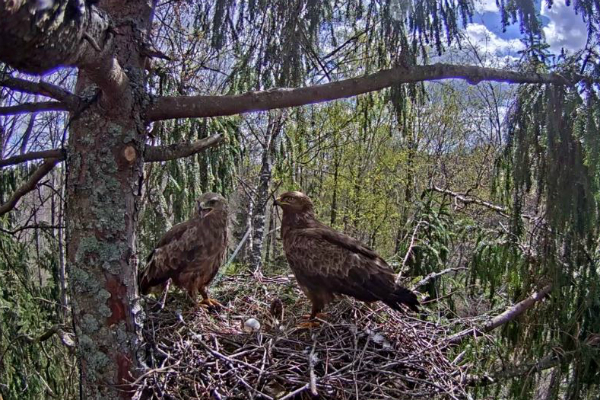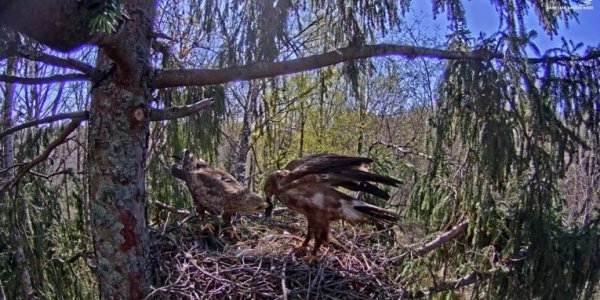Despite the Cold, the Lesser Spotted Eagle Couple Lay Their First Egg
For more than a month already, all nature enthusiasts can follow the lesser spotted eagle couple, who despite the cold have finally laid their first egg. The eagles have made their nest in a forest massif in Ziemeļlatgale Region Madona Forest District. In turn, the golden eagle that so rarely can be seen in Latvia may now be spotted by a patient observer in a nest, which is located in one of the swamps in the north-eastern region of Latvia. The eagles may be observed on-line, within the framework of JSC "Latvia's State Forests" (LVM) environmental education and research projects "Birds and Animals in Marsh" and "Lesser Spotted Eagles".
The lesser spotted eagle couple who have been named Betiņš and Betiņa could be heard in the vicinity of the nest very early - on 5 April; and a day later the male bird already visited the nest.
The fact that the male bird visited the nest alone, but from time to time eagle mating cries could be heard in the vicinity of the nest suggested that there might be another nest. Suspicions were confirmed, and on 8 April, upon searching the forest, a new nest was found 200 metres away; it was also made in a spruce-tree, about 20 metres above the ground. The nest was freshly supplemented with deciduous tree twigs; its hole was spread with fresh spruce sprigs in preparation for the big event. Luckily, also here it was possible to set up a camera to follow the lesser spotted eagles.
Around Easter, Betiņa started to settle down more and more comfortably in the nest, and it was expected that the first egg could be laid from 17-19 April. However, the hope of the joyful event decreased with the temperature drop. When after a week, the swamp was covered with snow the eagle couple could be spotted in their nest less and less frequently. There was a very small probability that an egg would be laid in the nest.
"It is the first time that I see that after the first copulation, the female bird is hesitating to lay the first egg. It is possible that affected by the severe cold, the formation of egg is not hormonally stimulated," says Uģis Bergmanis, LVM Senior Environmental Expert.
When we had lost all the hope, to our surprise with the first rays of the May sun, the first egg was finally laid. Egg hatching success will depend on the adequacy of feed - whether the male bird feeds the female bird several times a day and the egg is continuously heated. Hatching is expected to take place around 10 to 11 June.
Although the lesser spotted eagle is the most common species of eagles in Latvia (3700-4000 nesting couples or 12-17% of the world population), compared to other, numerically less frequent eagle species it is the most endangered species of eagles at a global scale. 95% of the lesser spotted eagle global population nest in Europe, where due to the intensive economic activities in many countries their number is decreasing. The availability of feed is the most important factor contributing to the breeding success and the size of population as a whole, and it is negatively affected by ploughing up of meadows, pastures and fallow land, which are replaced with crops. Lesser spotted eagles mostly feed on small rodents, frogs and moles. They nest in mature deciduous and mixed forests.
To keep track of the population, JSC "Latvia's State Forests" coordinates and implements monitoring of lesser spotted eagles in five plots; research results are published in a scientific journal.
See the publication in the scientific journal















